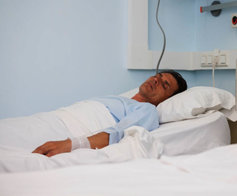How is Narconon Different from Rapid Detox?

Withdrawal is still the first step of recovery from addiction and the first phase in creating a new, sober life. It’s unfortunate that when an addicted person decides to get clean and sober, they have to first pass through an intensely uncomfortable withdrawal phase as they come off the drugs they were using and addicted to.
Withdrawal symptoms vary in nature and intensity depending on the drugs being taken. When people who are not familiar with addiction think of withdrawal, they normally think of alcohol or opiate withdrawal, because these are the ones most often portrayed in literature or movies.
For a few, withdrawal can be dangerous or even fatal; these cases must be carefully managed in a medical environment. Alcohol withdrawal can result in anxiety, hallucinations, fevers, seizures, comas and even death. Opiate withdrawal results in cramps, chills, fevers, insomnia, muscle and bone pain, irritability, nausea, and vomiting.
Cocaine and methamphetamine withdrawal may be different, not focused as strongly on physical symptoms. They can be marked by an initial “crash” in which a person suffers depression, anxiety, and intense drug cravings. Once this has passed, the person will probably be fatigued and apathetic and then may once again suffer intense drug cravings.
References:
In an effort to make it possible to withdraw from drugs without discomfort, a treatment called “rapid detox” was developed for opiate withdrawal. This could be used for anyone withdrawing from heroin addiction or for someone abusing and addicted to prescription drugs OxyContin, Vicodin, morphine, codeine, methadone, Lortab, Percocet or several other drugs.

In this form of treatment, a person wanting to withdraw from an opiate would be anesthetized and then a large dose of opiate-blocking drugs would be administered. Accelerated withdrawal symptoms would then result. The expectation was that when the person was brought out of the anesthesia, the worst of the withdrawal symptoms would be over.
In 2000, a report on the National Institutes of Health website reported that the procedure was gaining in popularity, but by 2010, it was being shunned in state medical guidelines as being too expensive and too dangerous. One reason was that vomiting ordinarily occurs during opiate withdrawal and vomiting while under anesthesia can be life-threatening. Several deaths were reported. Health practitioners began to realize that the dangers might outweigh any benefits.
One guideline for the administration of “rapid detox” called for the use of naltrexone (opiate blocker), propofol (anesthetic), ondansetron (prevents vomiting), octreotide (prevents diarrhea), clonidine (reduces blood pressure) and benzodiazepines (anti-anxiety and sedative.)
References:
Narconon Programs Make Withdrawal Tolerable
Research and experience over fifty years of providing drug detoxification proved that supplying the right nutrition during withdrawal would help lessen some of the worst withdrawal symptoms. Normally, addicts have severely neglected their own needs and arrive at a rehab facility poorly nourished and poorly rested.
In some cases, an individual may require a medically assisted wean-down, as it often the case with benzodiazepines or heavy alcohol abuse. If so, this would be completed before starting the nutritionally drug-free withdrawal at Narconon.
On the Narconon program, drug-free withdrawal starts by supplementing regular nourishing meals with a specific blend of vitamins including the B-vitamins that are destroyed by drug use and giving the recovering person a calcium-magnesium drink that can be easily absorbed by even a depleted body. Supplement doses are repeated throughout the day.
In addition to nutritional support, gentle re-orienting exercises with the staff help an addict realize that they are in a safe place of recovery at last. Most addicts arriving in rehab are anxious about recovering and may feel guilty and depressed about what they have done to themselves and their loved ones. These exercises begin to draw a person out of their concerns so they can focus on recovery and a drug-free future.

Calming physical assists, specific processes for relaxing spasms and relieving aches, help a recovering person through more of the physical side of withdrawal. When all withdrawal symptoms have abated, then the person is ready to begin the remaining steps of the Narconon drug rehabilitation program.
The overall result is a far more tolerable withdrawal than most people expect – but without the administration of any drugs. (A person on necessary medication would stay on that medication unless instructed otherwise by their physician.)
It is the exact right first step to a new drug-free life.